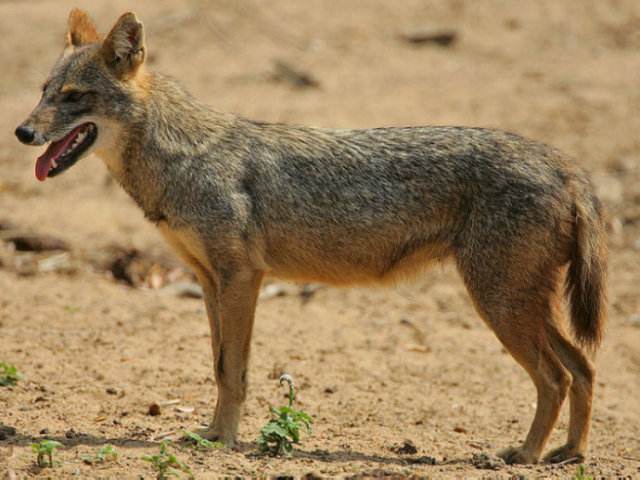Canis aureus
IUCN
LCBasic Information
Scientific classification
- name:Canis aureus
- Scientific Name:Asian jackal
- Outline:Carnivora
- Family:Carnivora Canidae Canis
Vital signs
- length:75-80cm
- Weight:7-14kg
- lifetime:8-10year
Feature
It is a nominative subspecies of the golden jackal.
Distribution and Habitat
Distributed in Iraq, Iran, Pakistan, western India (in the Kutch region of Gujarat), Saudi Arabia, Turkmenistan, Uzbekistan, Tajikistan, Kyrgyzstan, western Kazakhstan and Turkey.
On July 7, 2018, TBIC (Tibet Biodiversity Image Conservation Agency) confirmed for the first time that the Asian jackal is distributed in the wild in China through image evidence recording.
The Asian jackal lives in dry and open areas, open savannas, deserts and arid grasslands.
Appearance
The Asian jackal is of medium size and well-proportioned, with slender limbs and digitigrade nature, which is conducive to fast running. The head and palate are pointed, the face is long, the nose tip is prominent, the ears are pointed and upright, the sense of smell is sensitive, and the hearing is well developed. The canine teeth and carnassial teeth are well developed; the upper molars have obvious cusps, and the inner side of the lower molars has a small cusp and heel tip; the diameter of the molar crown is greater than the height of the outer incisor. The hair is thick and long. There are 4 to 5 toes on the front feet and 4 toes on the back feet; the claws are thick and blunt, and the tail is hairy.
The hair is relatively long and smooth, usually yellow to light gold, pale yellow or brown close to white, which varies with the distribution environment and seasons. Generally, the color is dark in the rainy season and light in the dry season. It has a long and fluffy tail. The cla
Details
The Asian jackal is a small jackal.

The sociality of the Asian jackal is highly developed, and cooperative hunting is their most important work, with a success rate of about three times that of individual hunting. Adult jackals in the group will put half-digested meat into their stomachs and then vomit it out for the young jackals to eat. The territory is marked by urine, about 2-3 kilometers, and the group members jointly defend the territory. Although the Asian jackal is an excellent hunter, it will not hunt larger animals. The Asian jackal will follow the lion and pick up their leftovers. Jackals also have the habit of storing food. The existence of mutual assistance in the group is crucial to the survival of the entire group, especially the young jackals.
The Asian jackal sometimes steals sugar cane, corn and watermelon, and attacks sheep and lambs. It is also a host of rabies. It can control the number of rodents and can also be domesticated. The behavior between their individuals is a bit like that of domestic dogs. Digging caves and howling are their collective activities.
The Asian jackal family structure is relatively stable and has a strong sense of territory. A family usually consists of a pair of leaders, their children who have not yet reached sexual maturity and newborns born last year. Group members raise newborns together.
Listed in the 2008 Red List of Endangered Species of the World Conservation Union (IUCN) ver 3.1-Least Concern (LC).
Listed in the second level of China's "National Key Protected Wildlife List" (February 5, 2021).
Listed in Appendix I, Appendix II and Appendix III of the Convention on International Trade in Endangered Species of Wild Fauna and Flora (CITES) 2019 Edition Appendix III.
Protect wild animals and stop eating game.
Maintaining ecological balance is everyone's responsibility!








